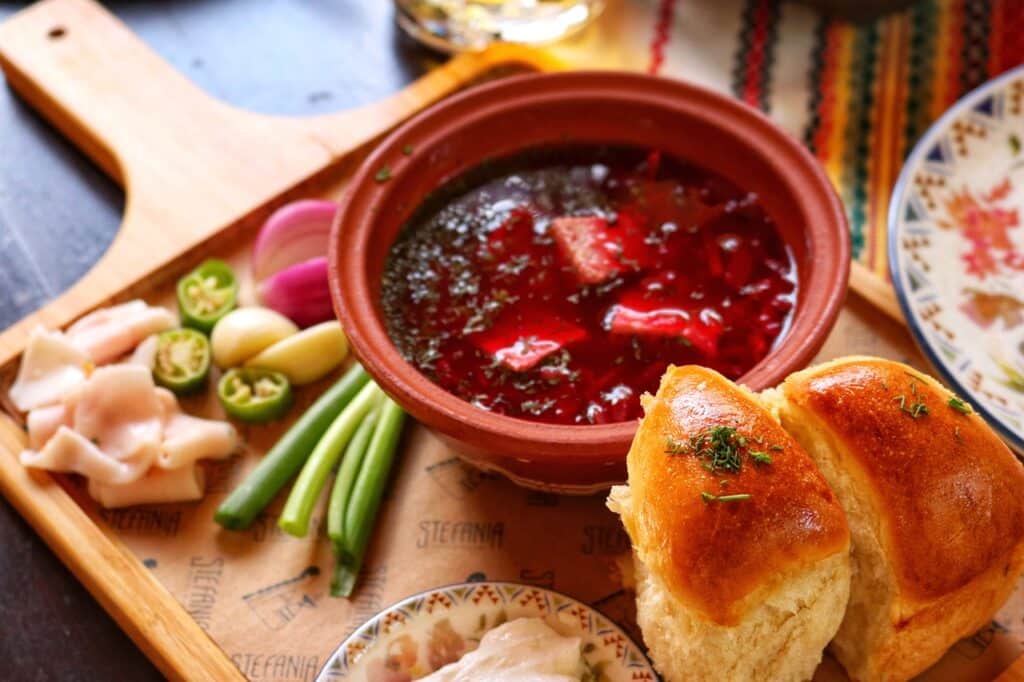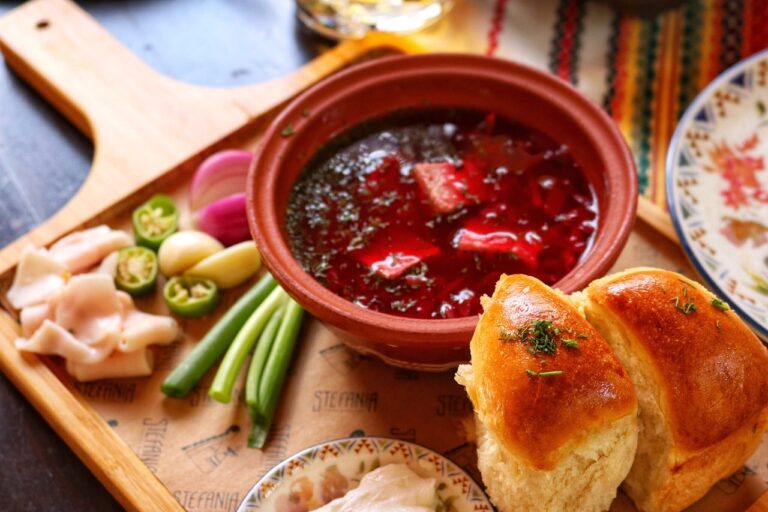
Borscht is Ukraine’s national dish, a vibrant and flavorful soup that represents the country’s rich culinary heritage.
Welcome to our guide on borscht, Ukraine’s national dish! In this article, we will delve into the fascinating facts surrounding this beloved culinary tradition. Borscht is a hearty soup that has been enjoyed by generations of Ukrainians and has gained popularity around the world.
Originating in Ukraine, borscht is a vibrant and flavorful dish that showcases the country’s rich culinary heritage. It is typically made with beets, cabbage, potatoes, and other vegetables, resulting in a vibrant red color and a unique taste. Borscht is often served with a dollop of sour cream and accompanied by crusty bread, making it a satisfying and comforting meal.
Our team at Remitly created this guide as part of our series that celebrates the traditional dishes of our global customers.
Borscht: A Brief History of Ukraine’s National Dish
Borscht has a long and fascinating history that stretches back centuries in Ukraine. The origins of this beloved soup are somewhat shrouded in mystery, but many food historians believe that borscht likely originated in the early Middle Ages. At that time, it was a simple soup made from whatever ingredients were available, including wild herbs, mushrooms, and game meat.
Over time, borscht evolved into a more complex dish, incorporating a wider range of ingredients such as potatoes, carrots, onions, and, of course, beets. The soup has gone through many variations over the years, but it has remained a staple of Ukrainian cuisine and an important symbol of the country’s culinary heritage.
Traditional Ingredients and Preparation of Borscht
While there are many variations of borscht, there are certain key ingredients that are typically included in the recipe. These include beets, cabbage, potatoes, onions, carrots, garlic, and sometimes meat or sausage. The soup is typically prepared by first roasting the beets, which gives them a sweet, earthy flavor. The other vegetables are then chopped and added to a pot, along with the roasted beets and any meat or sausage.
The mixture is cooked slowly over low heat, allowing the flavors to meld together and create a rich and complex broth. Once the soup is finished cooking, it is typically served with a dollop of sour cream and a slice of crusty bread.
The Role of Beetroot and Cabbage in Borscht
Beetroot is the key ingredient in borscht that gives the soup its signature vibrant red color. It also adds a subtle sweetness to the dish and provides a range of health benefits, including high levels of antioxidants and nutrients like vitamin C and folate.
Cabbage, on the other hand, provides a slightly sour flavor and a satisfying crunch to the soup. It is an important ingredient that helps to balance out the sweetness of the beets. Together, beets and cabbage create a unique and delicious flavor profile that is both hearty and comforting.
Borscht: A Staple Soup in Eastern European Cuisine
While borscht is most commonly associated with Ukraine, it is actually a staple soup throughout much of Eastern Europe. In countries like Poland, Russia, and Belarus, there are many variations of the soup, each with its own unique twists and flavors.
Despite the many regional variations, borscht remains an important symbol of Eastern European cuisine and culture. It is a dish that has been enjoyed by generations of people and has become a beloved part of many families’ culinary traditions.
Cultural Significance of Borscht in Ukraine
Borscht is not just a meal in Ukraine; it is a cultural symbol that represents the country’s rich history and traditions. It is a dish that is steeped in local folklore and has been passed down through generations of families.
In fact, borscht is so important to Ukrainian culture that it has its own museum in the city of Lviv. The museum is a testament to the deep cultural significance of this beloved soup and serves as a reminder of the important role that food plays in shaping our cultural identities.
Exploring Different Borscht Recipes
There are countless variations of borscht, with each region and family having their own unique take on the classic recipe. Some versions include meat or sausage, while others are strictly vegetarian. Some are served hot, while others are chilled.
If you’re interested in exploring the many different variations of borscht, there are plenty of recipes available online. You can also experiment with different ingredients and seasonings to create your own twist on this classic soup.
Health Benefits of Borscht: A Nutritious Delight
In addition to being delicious and comforting, borscht also provides a range of health benefits. The soup is packed with nutrients like vitamins C and K, as well as antioxidants that help to reduce inflammation and protect against chronic disease.
Beets, in particular, are a nutritional powerhouse that can boost your energy levels, improve your digestion, and promote healthy blood pressure. So the next time you enjoy a bowl of borscht, you can feel good knowing that you’re nourishing your body as well as your soul.
Borscht Recipe
Ingredients:
- 4 medium beets, roasted and peeled
- 1 small head of cabbage, shredded
- 2 medium potatoes, peeled and diced
- 1 large onion, diced
- 2 carrots, peeled and grated
- 3 cloves of garlic, minced
- 4 cups vegetable or beef broth
- 1 cup tomato puree
- 1 bay leaf
- 1 teaspoon dried dill
- Salt and pepper to taste
- Sour cream and fresh dill for garnish
Instructions:
- Start by roasting the beets. Preheat the oven to 400°F (200°C). Wrap each beet individually in aluminum foil and place them on a baking sheet. Roast for about 1 hour or until the beets are tender when pierced with a fork. Once roasted, let the beets cool, then peel and dice them into small cubes.
- In a large pot, heat some oil over medium heat. Add the diced onion and minced garlic, and sauté until they become translucent and fragrant.
- Add the grated carrots and diced potatoes to the pot, and cook for a few minutes until they start to soften.
- Stir in the shredded cabbage and diced beets, and cook for another 5 minutes, allowing the flavors to meld together.
- Pour in the vegetable or beef broth and tomato puree, and add the bay leaf and dried dill. Season with salt and pepper to taste.
- Bring the soup to a boil, then reduce the heat to low and let it simmer for about 30 minutes, or until the vegetables are tender.
- Remove the bay leaf from the pot and adjust the seasoning if needed.
- Serve the borscht hot, garnished with a dollop of sour cream and a sprinkle of fresh dill.
Enjoy this hearty and nutritious borscht as a comforting meal on its own or as a starter to a larger Ukrainian feast.
Learn More About Ukrainian Cuisine
Ukrainian cuisine is a rich and diverse culinary tradition that reflects the country’s history, geography, and cultural influences. It is characterized by hearty and flavorful dishes that are made with simple, locally sourced ingredients. Here are a few key aspects of Ukrainian cuisine that you may find interesting:
- Farm-to-Table Philosophy: Ukrainian cuisine is deeply rooted in the country’s agricultural heritage. Many traditional dishes feature ingredients that are grown or raised locally, such as potatoes, cabbage, beets, mushrooms, and various types of meat. This farm-to-table philosophy ensures that the food is fresh, flavorful, and sustainable.
- Bread and Wheat Products: Bread holds a special place in Ukrainian cuisine and is often considered the “soul” of a meal. Traditional Ukrainian bread, known as “korovai,” is made from wheat flour and is often decorated with intricate patterns and symbols. Wheat products like dumplings, pancakes, and pastries are also popular in Ukrainian cuisine.
- Diverse Flavors and Techniques: Ukrainian cuisine incorporates a wide range of flavors and cooking techniques. From hearty stews and soups like borscht and varenyky (dumplings) to savory meat dishes like holubtsi (stuffed cabbage rolls) and shashlik (grilled skewered meat), Ukrainian cuisine offers a variety of tastes and textures.
- Cultural Influences: Ukrainian cuisine has been influenced by neighboring countries and cultures throughout history. For example, the use of sour cream and dill in many dishes is reminiscent of Russian cuisine, while the inclusion of spices like paprika and caraway seeds reflects Hungarian and Polish influences.
- Festive Traditions: Ukrainian cuisine is closely tied to festive traditions and celebrations. Holidays like Christmas and Easter are marked by special dishes and rituals. For example, during Christmas, a twelve-course meal called “Sviata Vecheria” is prepared, featuring dishes like kutia (sweet grain pudding) and uzvar (dried fruit compote).
Exploring Ukrainian cuisine is a wonderful way to immerse yourself in the country’s culture and traditions. Whether you’re enjoying a bowl of borscht or savoring a plate of varenyky, each bite tells a story of Ukraine’s rich culinary heritage.
Visit the homepage, download our app, or check out our Help Center to get started.
